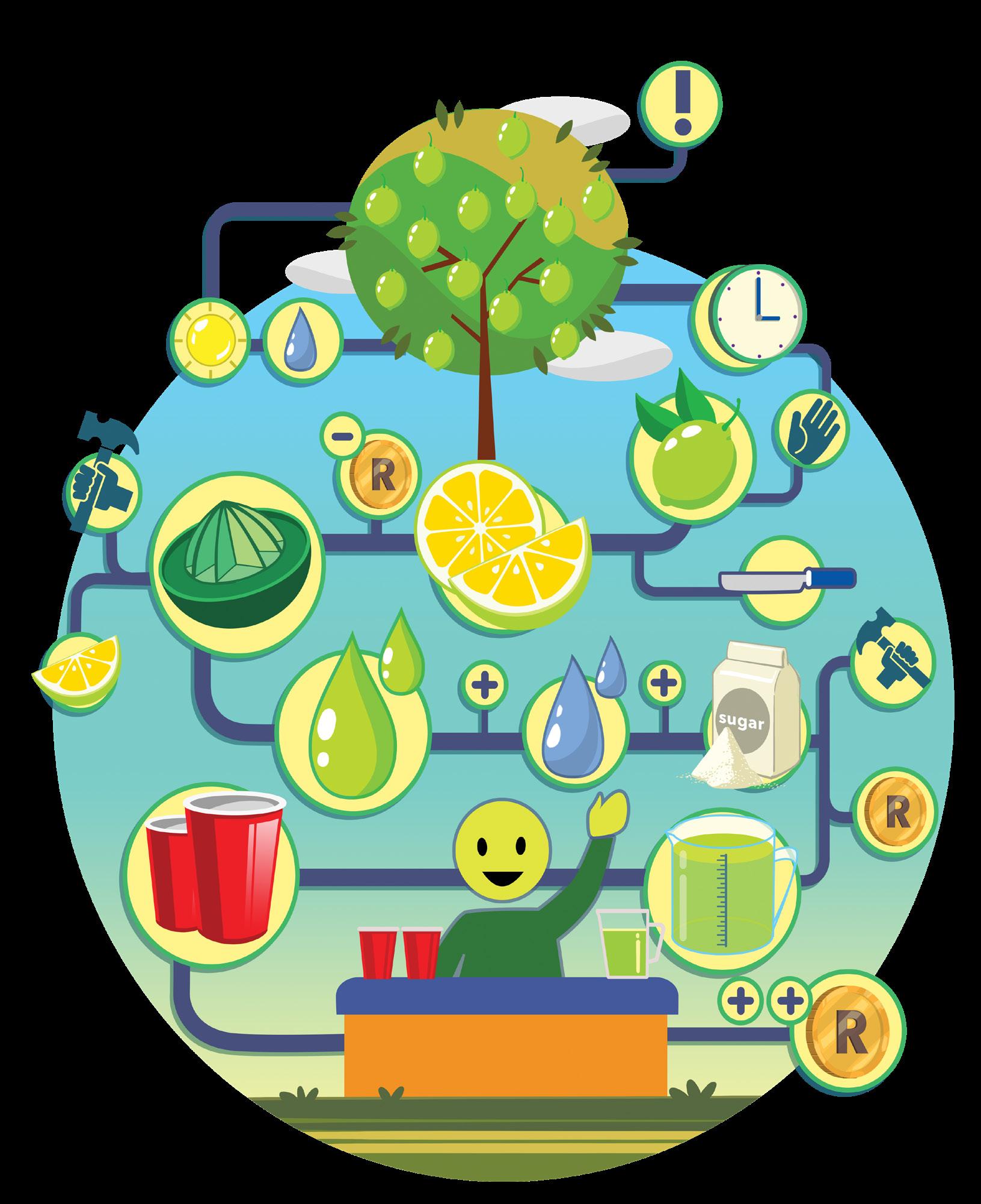Sample
Preface
Economic and Management Sciences consists of three components, namely the economy, entrepreneurship and financial literacy. The facilitator’s guide serves as support to the facilitator The facilitator must use the answers in this guide to assess learners’ activities and exercises
Each lesson must be thoroughly explained to learners, discussions should be held and all activities in the lesson as well as the revision activities must be completed by learners in preparation for tests or examinations. It is always good to go through the questions and answers with learners to give them feedback about possible errors or good answers, or tasks completed
The facilitator’s guide will guide both facilitators and learners through the year, and it should be used in conjunction with the study guide.
How to use the facilitator’s guide
1. The full content of the study guide must be presented to learners
2. Facilitators are responsible for ensuring that learners purchase a 72-page script for answering activities in the study guide.
3. Revision activities and activities given in a unit form part of the content that learners must complete and answer. This will help them better understand the content of the subject.
4. Set a deadline for when learners must complete the activities. Try to keep to the dates to ensure that all work is dealt with
5. All revision activities and activities given in a unit must be marked with the learners After marking the work, the answers should be discussed with them
6. It is recommended that learners write down the correct answers in their script for further reference and to study for tests and examinations.
7. If the facilitator provides the answers to learners without giving them the opportunity to do it themselves, they will obtain good marks but may not remember the content.
8. After marking and handing back formal assessment tasks, tests and examination answer papers, the facilitator can go through it with learners
9. All formal assessment tasks and tests are provided in the portfolio book. June and November examinations will be sent to you.
10. Each lesson is composed in such a way that learners can unhurriedly work through it. Each lesson has a time allocation, as required by CAPS.
11. If you have any queries about the subject, please contact the education specialist
Timetable and time management
The teaching time for Economic and Management Sciences comprises two hours per week. The following table shows how many weeks to spend on each topic per unit (taken from CAPS)
UNIT 1: THE ECONOMY
The economy: History of money
The economy: Needs and wants
The economy: Goods and services
The economy: Inequality and poverty
UNIT 2: FINANCIAL LITERACY
UNIT 3: ENTREPRENEURSHIP
UNIT 4: THE ECONOMY
• Set up a timetable for learners for each unit. Make sure they complete the work of each unit within the given timeframe.
• Stick to the proposed year plan or change it as you please.
• Do not allow learners to fall behind, otherwise they will struggle to catch up.
• Ensure that learners spend two hours each week on the subject
Assessment requirements
Assessment is a continuous, planned process of identifying, gathering and interpreting information about learners’ performance. Assessment in Economic and Management Sciences focuses on the knowledge, skills and values required to ensure informed, ethical, productive and responsible participation in the economy
Economic and Management Sciences covers valuable skills such as economic, entrepreneurial, financial and managerial skills that prepare learners for success in different economic and business environments. The facilitator must consider all these skills when teaching, learning and assessment take place.
Learners are assessed in two ways
1) Informal assessment
• It takes place during the teaching and learning process.
• It usually comprises the activities completed during lessons as well as discussions and observations.
• The results of informal assessment are not recorded.
2) Formal assessment
• All assessment tasks that form part of the formal assessment programme for the year are regarded as formal assessment.
• The assessment is formally assessed by a facilitator/tutor.
• Examples of formal assessments include tests, examinations and projects.
UNIT 1: THE ECONOMY
Learners must achieve the learning aims of each lesson before moving on to the next lesson/unit. Encourage learners to find additional information on all the study guide topics in magazines, newspapers and on the internet, and to bring it along to the next lesson. It will expand their knowledge of the topics discussed
The marks of the activities do not count towards the formal assessment mark. The mark allocation will, however, give learners a good indication of how long their answers should be. Learners must work through the answers with the facilitator/tutor and make corrections where necessary, so that they may know exactly where they have answered incorrectly
LEARNING AIMS
At the end of this lesson, learners must be able to:
• understand what a traditional society is
• fully discuss bartering.
• distinguish between promissory notes, coins, paper money and cheques.
• understand electronic banking.
• have a proper understanding of the role of money.
1 1. • They hunted wild animals for meat ✓
• They caught fish. ✓
• They used wild plants for food and medicine ✓ (3)
The Khoi-San ✓✓
• Goods did not have a set value because different societies attached different values to items. ✓
• Some goods were only available at certain times of the year and they could not be stored, e.g. perishable food. ✓
• For bartering to occur successfully, the two parties involved in the bartering process needed to have what the other wanted ✓ (3)
Lesson 1: History of money
4. A way of living in which people constantly move from place to place ✓ and have no permanent home ✓ (2)
5 Any FIVE of the following:
• Maize ✓
• Cattle ✓
• Sheep ✓
• Goats ✓
• Wheat ✓
• Fish
• Poultry (chickens) ✓
• Vegetables ✓
• Shells ✓ • Salt ✓ • Clay discs ✓
2.2 08/08 OR August 2008 ✓
2.3 08/12 OR August 2012 ✓ (1)
2.4 No,✓ the PIN cannot be found on the card – this serves as a safety measure, allowing the owner of the account only to use the card. ✓ (2)
3. Any FOUR of the following:
• Be vigilant at all times when using an ATM. ✓
• Keep your bank card in a safe place. ✓
• Choose a PIN that is easy to remember, but difficult to guess. ✓
• Do not write down your PIN or share it with anyone ✓
• When entering your PIN, cover the keypad so that nobody else can see it. ✓
• Do not trust strangers who offer to help you at the ATM; only trust bank officials. ✓
• Ensure that the card returned to you is in fact your card. ✓ (4)
4. • Capitec ✓ • FNB ✓
• Standard Bank ✓
• Nedbank ✓ • Absa ✓ (5)
5. Any FIVE of the following:
• Insert your bank card into the ATM slot. ✓
• Enter your PIN on the keypad. ✓
• Indicate what you want to do, e.g. withdraw or deposit money, etc. ✓
• Indicate the amount you want to withdraw or deposit. ✓
• Indicate whether you want a slip. ✓
• Take your money if you have withdrawn money, as well as your bank card and slip. ✓
If learners do not know how an ATM works, take them to an ATM and demonstrate the steps (5)
TOTAL: 20
Lesson 2: Needs and wants
LEARNING AIMS
At the end of this lesson, learners must be able to:
• distinguish between a need and a want.
• identify the basic needs of individuals, families, communities and countries.
• distinguish between primary and secondary needs.
• understand the concept of satisfying unlimited needs and wants with limited resources.
ACTIVITY 3
1. The person mostly buys groceries to satisfy his basic needs. (1) 2. No, he buys paraffin and candles. (2)
Food
Furniture
Books
Cars
Any three of the following: Food: Checkers, Pick n Pay, Spar, Game, Makro, etc.
Clothes: Edgars, Woolworths, Jet, Pep, Mr Price, etc
Any three of the following: House & Home, Coricraft, Bradlows, Russells, OK Furniture, etc.
Any three of the following: CNA, Exclusive Books, Bargain Books, CUM Books, etc.
Any three of the following: Toyota, Volkswagen, Ford, Nissan, Hyundai, Kia, BMW, etc.
(3 x 4) = (12)
3. The learner must paste the correct pictures under the correct headings. (5 x 2) = (10)
TOTAL: 30
ACTIVITY 5
1.1 air (oxygen) 1.2 water
1.3 food
1.4 house
1.5 safe
1.6 at ease
1.7 locked
1.8 friends
1.9 love
1.10 strong points
1.11 himself
1.12 acknowledge (12 x 1) = (12)
2.1 Physiological need – stores 2.2 Self-actualisation – schools
2.3 Physiological need – stores
2.4 Self-actualisation – universities (4 x 2) = (8)
Lesson 3: Goods and services
LEARNING AIMS
At the end of this lesson, learners must be able to:
• distinguish between goods and services.
• name examples of goods and services.
• identify the role of producers and consumers.
• identify the role of households as producers and consumers.
• identify the effective and efficient use of goods and services.
• recycle and reuse goods to satisfy needs and wants.
I am a bricklayer who works for a construction company.
Commercial services ✓
I am a hairdresser at the local shopping centre.
Personal services ✓
I am the principal at the local primary school.
Personal services ✓
I
on a fruit farm in a neighbouring town.
I am a truck driver who transports goods.
Commercial services ✓
I sell fruit at the traffic light.
Commercial services ✓
I am a cleaner at a big chain store.
Commercial services ✓
1.
ACTIVITY 7
• Conserve energy by using alternative and sustainable sources of energy, e.g. solar power, wind energy, biofuel, etc. ✓
• Conserve water ✓
• Reduce and recycle ✓
• Launch awareness campaigns and introduce education programmes to encourage the sustainable use and conservation of natural resources, e.g. the Go Green Initiative. ✓ (4)
2. Any THREE of the following:
• Paper-based waste: paper, cardboard, newspapers, magazines, books, etc ✓
• Plastic waste: cold drink bottles, ice cream tubs, milk containers, plastic bags, etc. ✓
• Glass: cold drink bottles, food jars, etc. ✓
• Organic waste: fruit and vegetable peels, etc. ✓
• Metal: cold drink bottles, food tins, paint cans, foil, etc. ✓ (3)
3. E-waste or electronic waste is discarded electronic devices or appliances, ✓ such as cellphones, computers or televisions ✓ (2)
4. To allow future generations to also meet their own needs ✓ (1) TOTAL: 10
LEARNING AIMS
At the end of this lesson, learners must be able to:
• discuss the causes of socio-economic imbalances.
• understand inequality in South Africa.
• understand education and skills to combat inequality and injustice.
• understand urban and rural challenges.
• understand the creation of sustainable job opportunities.
Lesson 4: Inequality and poverty
1.
• No school training
• Poverty
• Not enough money for food and clothes
• Unskilled labour
• Lack of water and sanitation
• Lack of proper housing (6) 2. No, she has been denied virtually all opportunities. (2)
Illiteracy, poverty, poor housing, few clothes.
4. Better housing, educational opportunities, water and sanitation, clothes.
5. She can get a qualification to work in a better paid profession. (1)
6. Yes, people find it difficult to shed the stigma of apartheid. The fact that opportunities have been denied to these people years ago, is still affecting their lives today. (3)
TOTAL: 20













